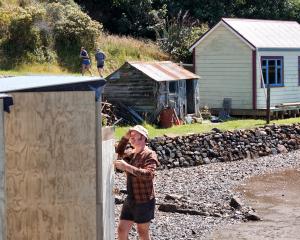When Beatrix Luskie and her partner installed new lighting in the kitchen of their St Kilda home a few months back, uppermost in her mind was the need for a well-lit area for her cake creations.
There have been carousel cakes, Barney cakes, Spongebob cakes and a princess cake in recent times as birthdays of friends and family have come and gone, with everyone looking to Beatrix for a fitting centrepiece.
So the new fittings in the kitchen host no fewer than 12 lamps, all individually angled for best effect.
Mrs Luskie admits that when she went out to buy the light fittings she did not ask too many questions about power consumption.
"I went by looks," she says.
Fortunately, Rexel lighting specialist Chris Hartman can help on the energy side.
Mrs Luskie was the winner of a recent "Right Light" lighting makeover competition run in the Otago Daily Times, in association with the Electricity Commission.
We are in her house, with Mr Hartman, to have a look at her light bulbs to see if there are savings to be made.
There are.
In fact in the kitchen alone, swapping the existing old-technology 50W 230V halogen bulbs for the latest 40W alternative provides an instant saving of 120W, without any loss of lighting for those tricky icing moments.
More could have been saved but the lights are on a dimmer, so fluorescents are not an option.
The new bulbs have a modern halogen burner, which gives a more intense, crisp, white light - and lasts twice as long.
Therein lies much of the light and heat in the lighting debate.
Your old-fashioned incandescent bulbs, the ones the previous Labour-led Government almost banned forever, are not very efficient.
They use only 5% of the energy they consume for lighting. The rest is lost as heat. It is not surprising when you consider their design has hardly changed in 120 years.
Back at Mrs Luskie's place, our lighting specialist has already binned quite a pile of those dinosaurs.
Just inside the front door a chandelier was earlier dragged into the 21st century.
Out went the three old 40W bulbs, in went the new 28W halogen lamps - which look the same as the old incandescents.
Saving for the three-bulb fitting: 36W.
There are bigger five-bulb fittings in the master bedroom and lounge (we need good lighting here for Mrs Luskie's sewing), providing another 120W in savings.
Again, more could have been saved by going to fluorescents, but Mr Hartman says that is not the whole story.
"These are a bit more decorative," he says of the halogen lamps chosen for the entrance, bedroom and lounge.
"You don't want [fluorescent] twist lamps hanging out of those."
There is also the issue of the couple of minutes it takes for the fluorescents to boot up to full glow.
"In the bedroom first thing in the morning you just want some light, boom," Mr Hartman says.
In the bathroom it is out with the old 100W element and in with the 18W fluorescent.
The laundry gets much the same treatment.
Outside, Mr Hartman has also found savings.
There are several security lights out the back, in which he has replaced old-school 150W bulbs with new-tech 120s.
Again, the super-efficient fluorescents weren't the best option here.
"We could have used 23W compact fluorescents but the idea with security fittings is that you want plenty of light straight away."
So, the upshot is that a quick sweep through the Luskie household has carved out not inconsiderable savings in terms of energy usage and cost to the family.
Had the focus been entirely on energy savings more could have been done, but as Mr Hartman says, there are other considerations and lighting features are more often than not bought for their aesthetic appeal.
While there are easy savings to be made now, Mr Hartman says LED lighting could be the future.
Light output still needs to be improved but LEDs are already way out in front in terms of life expectancy, at 60,000 to 100,000 hours.
Cost savings per room
Lounge (based on 3hrs a day): 10 x 28w Osram Halogen Classic, $52 per year to run. Replacing 10 x 40w gls lamps, $74 per year. Saving of $22 per year.
Kitchen/dining (based on 3hrs a day): 15 x 40w Osram 240v halogen, $111 per year to run. Replacing: 15 x 50w 240v halogen, $139 per year. Saving of $28 per year.
Laundry (based on 1hr a day): 1 x Osram 18w CFL lamp $1.10 per year to run. Replacing: 1 x 100w gls lamp, $6.20 per year. Saving of $5.10 per year.
Hallway (based on 1hr a day): 3 x Osram 28w halogen classic lamp, $5.21 per year; 2 x 18w Osram CFL Lamp, $2.20 per year. Replacing: 3 x 40w gls lamps $7.45 per year; 2 x 100w gls lamp, $12.40 to run. Savings of $12.44.
Bathroom (based on 1hr a day): 1 x Osram 18w CFL lamp, $1.10 per year to run. Replacing: 1 x 100w gls lamp, $6.20 per year. Saving of $5.10 per year.
Boy's room (based on 2hrs a day): 1 x Osram 18w CFL lamp, $2.20 per year to run; 2 x Osram 8w CFL lamp, $2 per year. Replacing: 1 x 100w gls lamp, $12.40 per year to run; 2 x 40w gls lamps, $9.90 per year. Saving of $17.90 per year.
Girls' room (based on 2hrs a day): 1 x Osram 18w CFL lamp, $2.20 per year to run; 1 x 28w Osram halogen candle lamp, $3.50 per year. Replacing: 1 x 100w gls lamp, $12.40 per year; 1 x 40w candle lamp, $4.95 a year. Saving of $11.65 per year.











